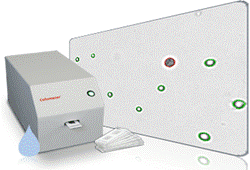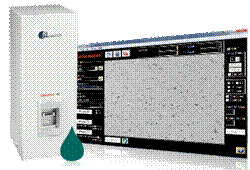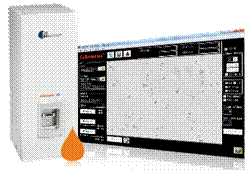Cell counter selection
Some routine operations in cell biology research are only a trivial but very important step in the entire project. These conventional operations are simple and have no technical connotation, but they consume a lot of time and effort of the researcher, and the results cannot be guaranteed. Manual blood cell counting under the microscope is the first to use the blood cell counting plate.
Manual counting not only wastes most of the researcher's time, but the tedious counting process is often dizzying, affecting the enthusiasm of the researchers, and the feeling of being overkill. Many researchers have raised their cell counts and shook their heads frequently, which is not only time-consuming and laborious, boring, and has no sense of accomplishment. At the same time, the subjectiveness of manual counting is strong, resulting in greatly reduced reliability of the counting results and poor repeatability. The results of counting between different operators are inconsistent and incomparable, resulting in experimental results often failing to reproduce.
Nowadays, society is a fast-developing society. Automation replaces the manual society. Speed ​​and efficiency are the focus of social attention. The automatic cell counting analyzer is also compliant with the requirements of the times and should be listed by the needs of researchers and scientific fields. The fully automated cell counting analyzer gets rid of the pain and annoyance of manually counting cells. At the same time, the results are more accurate and objective, the operation is quick and easy, and the repeatability is good. In particular, we save valuable time and enable researchers to put more energy into more important work.
At present, there are also a variety of brand automatic cell counters on the market, based on cell images, but also based on the coulter principle, but the main purpose is to free the manual from the tedious manual counting, to rule out the operator's subjectivity.
Xiaobian believes that the choice of cell counter should follow several points:
1. Consider the cost performance of the cytometer: If your purpose is to replace the manual counting, save the operator's time, easy to operate, there is no need to spend hundreds of thousands to buy a device that can only count cells, spend a lot of money to do small things .
2. Consider the stability and repeatability of the cell counter: If you have high accuracy and repeatability for cell counting, the high performance and stability of the instrument are the primary considerations, and the hardware and supporting software of the instrument are stable. To be considered, you cannot pursue low prices blindly.
3. Consider choosing the right model for your cell type: If your sample is a primary cell with a complex background and severe red blood cell and platelet contamination, you want to quickly and accurately count nucleated cells and perform accurate cell viability analysis. Sexuality directly affects the success and reproducibility of subsequent experiments. Then don't yell at your money at this time, the dual fluorescent cell count & vitality analyzer will be worth your blood.
4. Consider the multi-functional testing needs of the laboratory: if the cell counting and viability analysis are only part of the laboratory requirements, the laboratory will also perform functional tests such as apoptosis, cell cycle, GFP, etc., and the laboratory has no supporting instruments. Equipping the lab with a versatile cell counter is the best choice for you to go to other labs for help, get around the corner, and easily, easily, and at your own pace to get the desired results.
Here are a dozen of Cellometer series of cell counters from Nexcelom, USA. Xiaobian introduces you how to make a choice.
Before introducing the instrument, let me introduce the Nexcelom company. The American Nexcelom company was co-founded by Chinese couples Peter Li and Jean Qiu in 2003. The initial product was a disposable cell counting plate, which replaced the glass blood cell counting plate and solved the problem of repeated cleaning and pollution. . Driven by user needs and suggestions, Nexcelom has not developed a series of cell counters, so we will see Nexcelom constantly surprise and innovate for us, and I am sure that Nexcelom will continue to do so in the future. Surprise everyone. These are all attributed to Nexcelom's main focus on: 1. Focus on user needs and recommendations; 2. Focus on continuous innovation; 3. Focus on user experience and satisfaction.
Although Nexcelom is not a well-known large company in the biological field, it is a pioneer in cell counting instrument cell counting instruments. It has developed a cell counting instrument for ten years. This is another internationally renowned company brand. The same kind of cell counters fall far behind.
In terms of concentration, unlike other companies whose cell counters are just acquired brands, or if only one or two cell counters are no longer developed and innovated, Nexcelom has focused its attention on the field of cell counting, or around Cell counting is in this area, so Nexcelom has developed a family of cell counters with one or twenty models available.
This is Nexcelom, a large company that is not well-known, but it is hard to listen to the needs of users, to solve the needs of users with care, to innovate and develop with heart, it is worth our trust and respect.

For the Cellometer series of cell counter products, from bright field to fluorescence, from cell counting to vitality analysis to cell function detection, from computer control to built-in computer, it can meet various experimental needs and various user experiences. Instrument function, user experience. Be careful to make your eyes dazzled, how should we choose?
We can classify the Cellometer cell counter family by low, medium, and high.
1. Low-end cell counter - bright field cell counter
For the bright field cytometer, Nexcelom has three instruments to choose from, from which you can see the good intentions of the manufacturers. The three cell counters use brightfield imaging and pattern recognition to quickly and accurately count and perform live cell counting by trypan blue exclusion. Imaging, counting, and analysis are completed quickly within 30 seconds.
Among the many competitors, the Cellometer cell counter has always been known for its powerful functions. It can store cell images while counting cells. The saved cell images can be recalled and analyzed at any time, so that the results are traceable. The unique software can not only perform multiple cell parameter setting, cluster cell counting, irregular cell counting, cell debris elimination function, thus ensuring the accuracy of cell counting, but also a library of more than 300 cell parameters. Tune with.
1) AUTO T4 model - classic automatic cell counter

This is the first cell counter developed by Nexcelom and is the most widely used automatic cell counter in the field of research.
Features:
a. Computer control software, known for its stable performance and powerful functions;
b. IQOQ is available, which is GMP/GLP compliant and is required for industrial users to produce;
Recommendation: It is the best choice for industrial users' production workshops.
2) Mini model - the most cost-effective automatic cell counter

This instrument is a new cell counter from Nexcelom in 2013. The instrument, like its name Mini, is a compact and stylish combination, but its most lethality is its high cost performance, allowing domestic and foreign brands to count cells. The instrument is far behind.
Features:
a small and stylish, very suitable for crowded cell rooms;
b. High cost performance is its killer;
c. computer control software;
d. Can be used with a touch screen computer or a stylish tablet.
Recommended: Cell line & background is the best choice for clean primary cell counts.
3) AUTO1000 model - integrated cell counter

The instrument is also a new cell counter from Nexcelom in 2013, with an integrated design concept. Its built-in computer and large 10-inch LCD HD touch screen make the operation handy, and you can't put it down after use.
Features:
a. Integrated design concept with built-in computer;
b. 10-inch LCD HD touch screen.
Recommendation: The best choice for users who are looking for integration & pursuit of experience.
2. Mid-range cell counter - fixed dual fluorescent cell counter
In this cytometer, Nexcelom is the only one, and also offers three dual fluorescent cell counting & vitality analyzers according to user needs.
1) AUTO2000 model - dual fluorescent cell viability analyzer

The instrument uses an integrated design to detect red blood cells (nuclear-free) by dual fluorescence detection of AO (all nucleated cells stained green fluorescence) / PI (all dead nucleated cells stained with red fluorescence) ), platelet, cell debris contamination, accurate counting of nucleated cells and cell viability analysis, making it the best choice for primary cell counting and viability analysis.
You may think that a counter is out of your expectations, but when you use it, there will be a feeling of "seeking him thousands of miles", so that you can be sure that he is, and you can't put it down.
For example, when you count PBMC samples, dozens of samples, the separated samples vary widely, not to mention the patient sample. How to quickly and accurately count PBMC, how to eliminate the interference of red blood cells and platelets is your biggest headache. The listing of AUTO2000 just solves your problems.
Features:
a. Integrated design concept with built-in computer;
b. 10-inch LCD HD touch screen;
c. Dual fluorescence and bright field imaging: for AO/PI fluorescent dye or trypan blue to detect living dead cells;
Recommended: The best choice for primary cell counting and viability analysis.
2) K2 model - dual fluorescent cell analyzer

The K2 model counter is another dual fluorescent cell counter after the AUTO2000 model. In addition to the cell viability analysis function, this model can also be equipped with FCS EXPRESS streaming software for detection and analysis of apoptosis, cell cycle, and GFP protein expression after transfection.
Features:
a. computer control software;
b. Dual fluorescence and bright field imaging: for AO/PI fluorescent dye or trypan blue detection of living dead cells;
c. Not only can be used for cell counting, cell viability analysis, but also FCS EXPRESS streaming software for detection and analysis of apoptosis, cell cycle, and GFP protein expression after transfection.
Recommendation: The best choice for primary cell counting and viability analysis; and the selection of laboratory instruments for cell function testing in addition to cell counting.
3) X2 model - double fluorescent yeast cell viability analyzer

One of the advantages of the Nexcelom series of counters is the fine classification of the instruments for different needs. Users can choose the one that suits their needs according to their needs. X2 is designed for the sub-segment of small cells and can be used for counting and viability analysis of platelets, yeast, algae, etc.
Features:
d. computer control software;
e. Dual fluorescence and bright field imaging: for AO/PI fluorescent dye detection of living dead cells;
f. A dedicated counter for yeast, platelet, algae count and viability analysis.
Recommended: Best choice for yeast, platelet, algae count and viability analysis.
3. High-grade cell counter - dual fluorescence cell counter with flow analysis
1) K2 model - dual fluorescent cell analyzer (medium and high-end cell counter)

The K2 model counter is another dual fluorescent cell counter after the AUTO2000 model. In addition to the cell viability analysis function, this model can also be equipped with FCS EXPRESS streaming software for detection and analysis of apoptosis, cell cycle, and GFP protein expression after transfection.
Features:
g. computer control software;
h. Dual fluorescence and bright field imaging: for AO/PI fluorescent dye or trypan blue detection of living dead cells;
i. Not only can be used for cell counting, cell viability analysis, but also FCS EXPRESS streaming software for detection and analysis of apoptosis, cell cycle, and GFP protein expression after transfection.
Recommendation: The best choice for primary cell counting and viability analysis; and the selection of laboratory instruments for cell function testing in addition to cell counting.
2) VISION CBA - Dual Fluorescent Cell Function Analysis System

VISION CBA, VISION Cell-Based Assay System, not only provides cell counting, cell viability analysis, but also a high-end instrument for detection and analysis of apoptosis, cell cycle, and GFP protein expression after transfection.
Features:
a. computer control software;
b. Dual fluorescence and bright field imaging: two fluorescent filters are standard; multiple filters are optional and can be easily replaced by users;
c. Non-liquid flow system: no need to clean, no cross-contamination, small dosage (20ul);
d. Contains FCS EXPRESS streaming software: can detect and analyze apoptosis, cell cycle, GFP protein expression after transfection;
e. Combine cell counting, cell viability analysis, and cell function analysis;
f. No need for streaming appointments, no need to wait in line, analyze at any time, operate in person, easy and simple.
Recommendation: The laboratory not only needs cell counting and viability analysis, but also needs cell function analysis, and there is no supporting instrument in the laboratory. This instrument will be your best choice.
Thymosin is a hormone secreted from the thymus. Its primary function is to stimulate the production of T cells, which are an important part of the immune system. Thymosin also assists in the development of B cells to plasma cells to produce antibodies. In addition to its role as a major actin-sequestering molecule, Thymosin Beta 4 plays a role in tissue repair.
Aicar Powder,Adipotide Powder,Dermorphin Powders,Bodybuilding Raw Powder
Shaanxi YXchuang Biotechnology Co., Ltd , https://www.peptide-nootropics.com